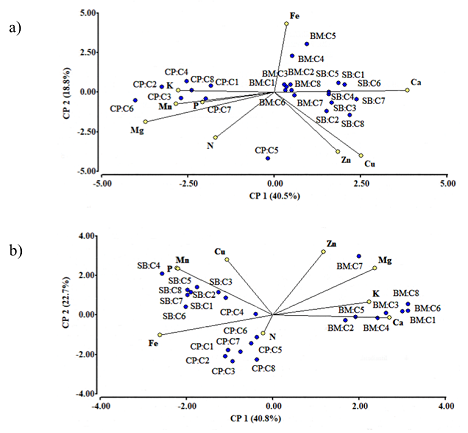Arbuscular mycorrhizal fungus and organics substrates effect on bean plant morphology and minerals
DOI:
https://doi.org/10.28940/terra.v40i0.1012Keywords:
agronomic characteristics, colonization, endomycorrhiza, inoculationAbstract
Arbuscular mycorrhizal fungi (AMF) are obligate symbionts that require a host plant (tramp) and support (substrates) to be applied as bio-fertilizers in agriculture. The objective of this study is to assess eight native AMF consortia of semi-arid zones (C1-ART, C2-GEC, C3-PAR, C4-VIE, C5-CUC, C6-SAC, C7-SAB, and C8-MUZ) and their reproduction response in three organic substrates: coffee pulp (CP), bovine manure (BM) and sugarcane bagasse (SB) on bean Phaseolus vulgaris. Plant height, stem diameter, number of leaves, root length, fresh and dry biomass, and mineral content in root were measured. The organic substrates (CP and BM) and C5-CUC and C8-MUZ consortia increased plant height, root length, and total fresh and dry biomass considerably. After day 75 of inoculation, root colonization oscillated from 5.7% in C8-MUZ to 46.1% in C2-GEC and C4-VIE; the greatest number of spores (201) was obtained in CP substrate in a 100-g sample. N, P, K, Ca, Mg, Fe, Zn, Cu, and Mn contents in root and leaves were signif icantly high (P ≤ 0.001). To conclude, native AMF inoculation and substrates had positive effects on biomass content and nutrient levels in leaf and root with the C2-GEC and C3-PAR consortia and CP and BM substrates, which produced better effects in beans, making them a biofertilization alternative in agricultural crops.
Downloads
Publication Facts
Reviewer profiles N/A
Author statements
- Academic society
- Terra Latinoamericana
- Publisher
- Mexican Society of Soil Science, C.A.

















